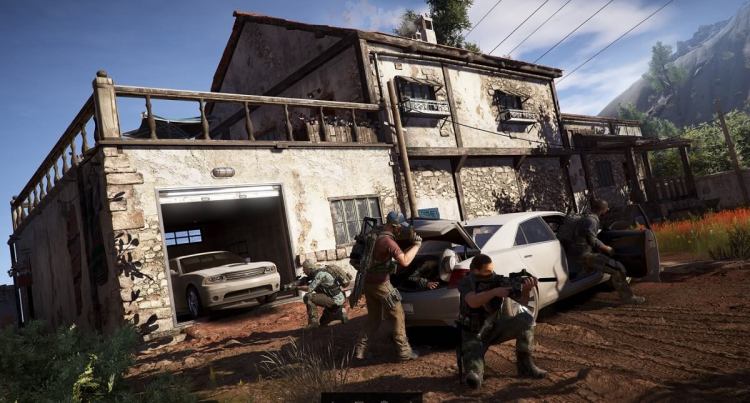Ghost Recon Wildlands has incredible environments where you can climb to a mountaintop and then visit everything that you can see from that mountain.
I saw the game in a preview last week at Ubisoft in San Francisco, and then I did an interview with Nouredine Abboud, senior producer at Ubisoft on the game. When I played, I had to start pecking away at the huge task of breaking the grip of the drug lords over the entire country. Every place I went was hostile territory.
He said that Ubisoft hopes that players will realize just how much freedom they have in the world, which is a kind of replica of Bolivia with 21 provinces and 11 different ecosystems. Your job is to take out El Sueno, the leader of the Santa Blanca Cartel, which has taken over the cocaine business in the country. You also have to deal with the military, which is in cahoots with the cartel, and help the rebels fight back.
But you only have four soldiers, the ghosts who operate in the shadows. Can you do it? Here’s an edited transcript of our conversation. Here’s our preview of the game, interview with the lead game designer, and our videos.
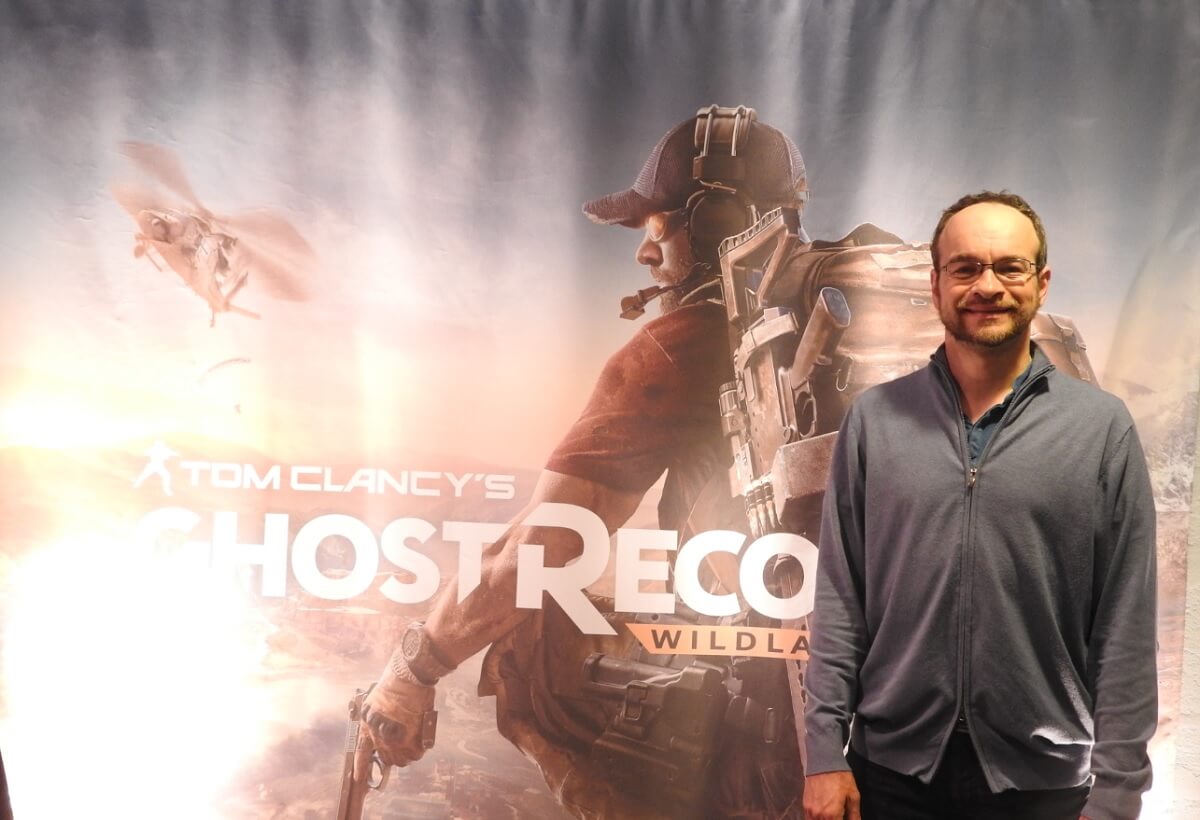
Above: Nouredine Abboud, senior product of Ghost Recon Wildlands.
GB: How long ago did you join the project?
Nouredine Abboud: I worked on Advanced Warfighter 2 and Future Soldier. We started this project when we finished Future Soldier in July of 2012. So it’s been nearly five years.
GB: That’s a long time with the franchise. Why have you stuck with it?
Abboud: It’s two things. In terms of gameplay, it’s always been a very deep franchise. All of the games have brought something unique in how they play. It’s also a franchise where we’ve always had the possibility to bring in new ambitions. In this game, with the new consoles and high-end PCs, we were able to deliver the dream of creating a game that’s both a military shooter, what Ghost Recon is famous for, but also this massive open world. You can play four-player co-op and have everyone moving back and forth as if they were playing solo. For me it was a fantastic opportunity, and the same was true for the whole team. We have some great ideas for the future, too. There are always new things to do.
GB: Was there a clear direction you wanted to go that was different from Future Soldier and the earlier games?
Abboud: If you look the three basic elements here — a military shooter, a massive open world, and four-player co-op — there’s no other game on the market that has those at the same time. Being able to play a tactical shooter in a big open world where you can move from mission to mission and play the whole story in co-op, or switching back and forth between co-op and single-player, that’s never been done before. So the general approach is very different.
If you go into the details, having this gigantic map is new to the series, But also — I’ve been making games for many years, and I’ve been playing games for more than 30 years. Initially playing games online was very complicated. Then you had LAN games and things like that. Now, imagine that you only have an hour to play, so you begin to play solo. A friend of your shows up online and asks to join your game. They can come into your mission right away, seamlessly, and you’ll play co-op for as long as you want to. If you have some more time, you can go into the public matchmaking and find two other guys to join you. If someone wants to log out and go to sleep, the rest of you can keep playing. The ability to play the same game, the same missions, without having to reload or create a new save, that’s never been done before.
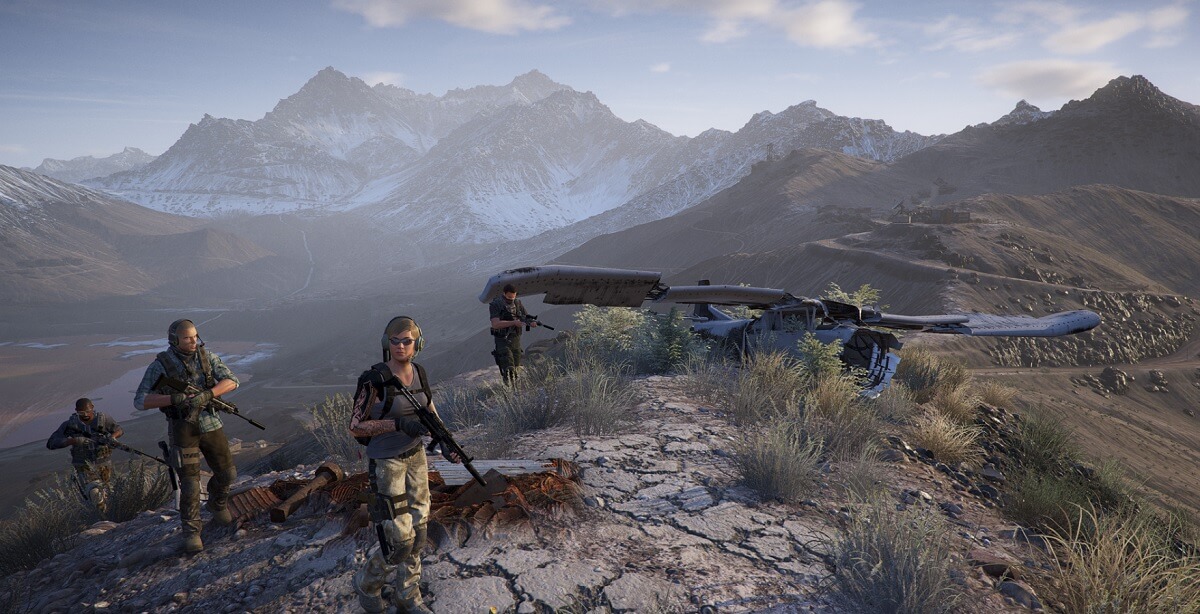
Above: Every location in Ghost Recon Wildlands is playable.
GB: It almost sounds like an MMO game.
Abboud: All sorts of online experiences have their strengths and weaknesses. The big strength of our game is that you can have the online experience with three other players, but because we’re only talking about that small group of people — four people, not 40 or 400 — we can go very deep in terms of gameplay, graphics, and tactics. We sometimes say that two is a crowd in action games. But here, four people is the right number to have lots of new situations. You can create a lot of chaos with just four people. And we can still have very strong graphics, a very deep draw distance. We have a lot of A.I. characters with their own complex patterns, a lot of vehicles with their own physics. You couldn’t do that in an MMO. We took what we wanted to take from other kinds of multiplayer games, but we wanted to bring that to the very deep gameplay that people expect from a Ghost Recon game.
GB: It’s very different from The Division as well, where you had a lot of people focused on a small space.
Abboud: We’re all in contact with other parts of Ubisoft and we know what’s happening with other games in development. Right now, big triple-A games are all trying to push some particular strength. In our cases, I think what we have is quite unique.
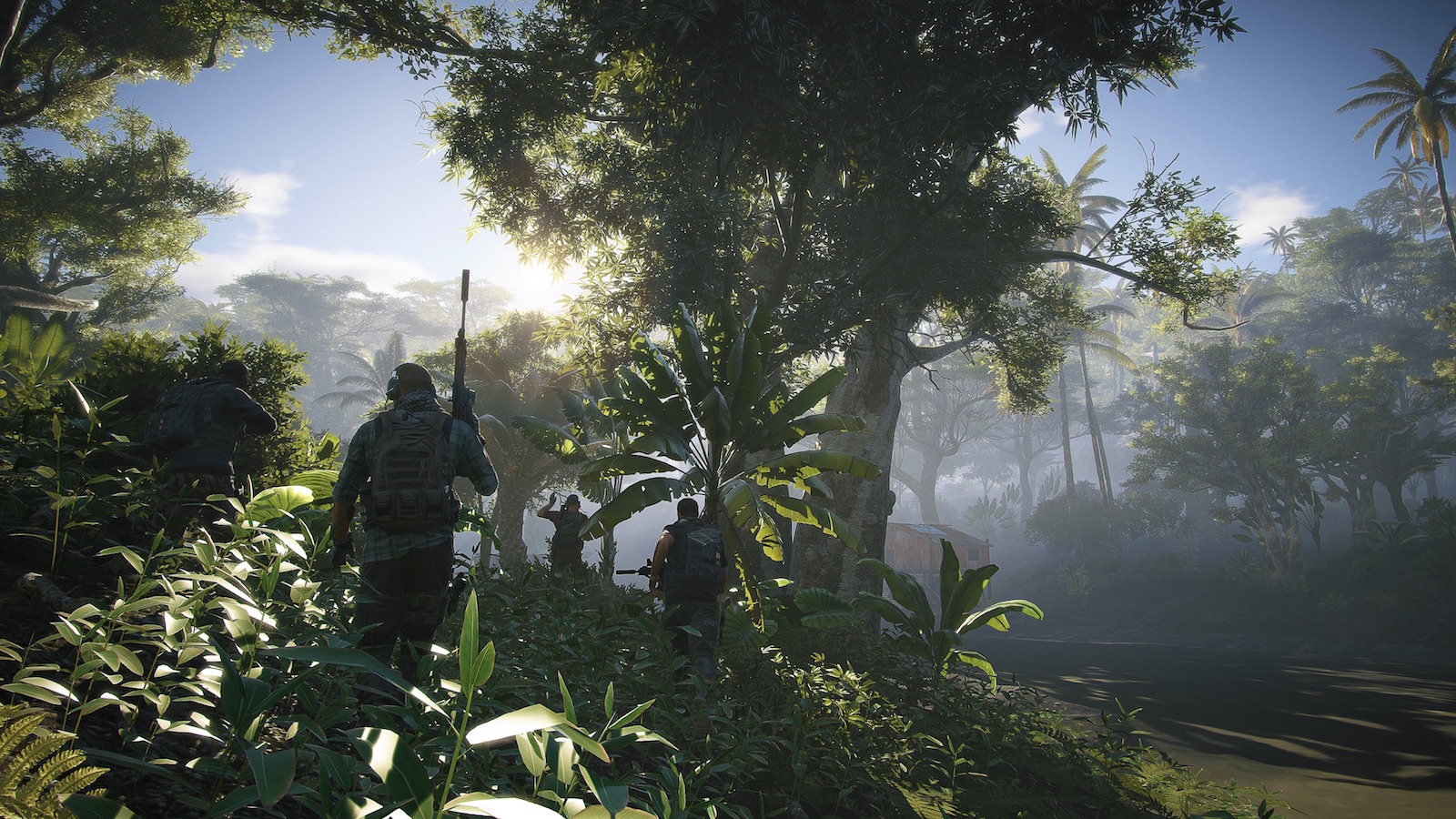
Above: The jungles of Bolivia.
GB: How many people did it take to work on this over five years? Is there anything along the way that’s helped you add efficiency to the process?
Abboud: The first thing it took is time, obviously. It’ll be almost six years once we’re finished. On the other hand, though, it’s not necessarily that you need to have lots of people working the whole time. It’s that you need time to develop your ideas. You need a concept phase, a preproduction phase, periods when you don’t have very many people, but you need time to build ideas and prototypes. You need to be able to put something aside, take time to think about it, and come back to it. It’s not massive production all the time.
When it comes to efficiency, the big thing I’ve said to the team is that if everything we do is in the build, that’s worth it. The issue is when you do lots of things, you make the wrong decisions, they don’t work, and you have to throw stuff away. Like they say in the movies, if you can see it on the screen, it was worth it. In the same way, for this game, we believe that everything we’ve done for the last five years can be seen on the screen. We have this massive world, 21 regions, 60 vehicles, all the A.I., all the gameplay — when you get your hands on the game, you can feel all that content. We didn’t throw our work away.
We have a very senior team — people who have 10, 15, 20, even 25 years of experience in the game industry — and we’re very passionate about our work. A lot of the stuff we did here has been tried and tested in the past. We tried some things on Future Soldier and decided to refine them for this game, like the Gunsmith. Clearly we didn’t start from scratch there. Some things we weren’t as happy about on our past projects, we were able to take them to the next level here.
GB: With the massive world, it seems like the challenge is to make every part of it interesting. At the very beginning there, I was in a car, and I was about three kilometers away from the target on a nearby mountain. It made me wonder, do I really want to drive that entire way, or do I just want to fast travel there? How closely do you have to watch out for those kinds of lulls in the experience?
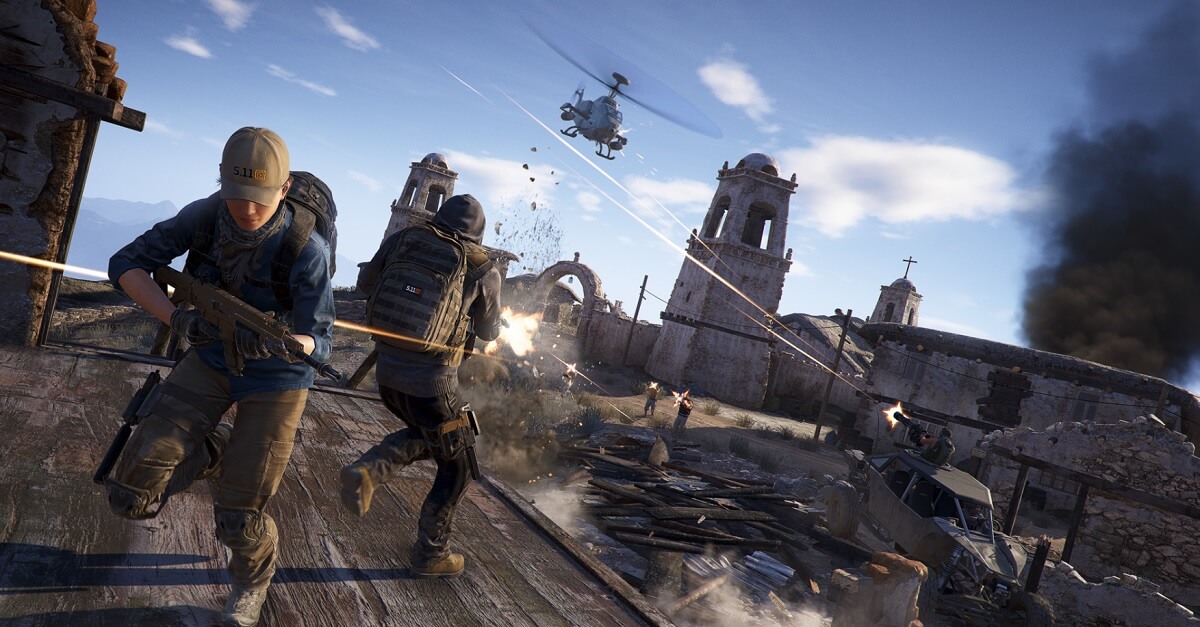
Above: Ghost Recon Wildlands has four-soldier squads.
Abboud: To be clear, there are going to be situations – especially when you’ve played the game for a while and you’ve gotten into the progression – where you’ll want to use the fast travel. What we face is the concept of distance. If you’re down in a valley and look up at a mountain, it needs to be high enough. If we make it not so high so it’ll be easier to get to the top, that does something for us in terms of gameplay, but visually it won’t work. No matter what, we have to take into account the reality of what we’re presenting. We also need a certain amount of space so that four players can have some space in the world, and so that helicopters and planes can be a meaningful way to get around. They need to be able to go at a certain speed.
Once that’s been laid down, what’s important is that in this game you’re behind enemy lines, in an area that’s full of bad guys. There’s always action. Yes, there will be some moments where the fun just comes from driving around. Sometimes you’ll know where to use a particularly fast road to get somewhere quickly. But something we worked very hard on — and that’s why we chose a setting where the cartel is in control, where they have a big impact on the population — is making this feel like you’re in the most dangerous place on earth. You’re almost never going to feel like you can completely relax. You’ll always feel like something might be about to happen.
In terms of gameplay, we have what we call systemic activities. Things will spawn that you have to deal with, like patrols from the cartel. Things will happen in traffic. Different parts of the world around you will interact with each other. We have the Unidad, the military, which is sometimes working with Santa Blanca, but there can also be situations where they’ll oppose each other. Maybe you’ll be driving along and you think you have plenty of time, but if someone from Santa Blanca starts shooting at you, the Unidad might start shooting at them. It’s going to make your drive that initially looked very simple into a whole separate adventure.

Above: So begins your four-soldier war against the Santa Blanca cartel in Ghost Recon Wildlands.
GB: That definitely happened to us during our co-op game. We were leaning out the car windows with our guns drawn when we passed by a parked Unidad truck. They took great offense to that.
Abboud: Exactly. For us as a team, the most fun we get out of this game, now that we’ve put all the pieces together, is seeing how people play with it and come up with crazy ideas. Of course we’ve played the game a lot ourselves, but everybody runs into a different story. There are so many elements in so many combinations. We have some people from the team here setting up the technical aspects of this event, and when they take a break they still play the game, even though they’ve been working on it for years. They still have fun playing with this toy we’ve built.
GB: It seems like you couldn’t really count the number of hours you could play with it.
Abboud: It’s like I say about a toy. It gives you a lot of different ways of playing with it. You’ll get better at it over time, and you’ll learn different things you can do with it, so in some ways you’re going to change. But you’ll also play it with other people, and that’s very important. If you look at all kinds of other games and sports, what makes the difference is the players. The universe, the setting that comes with the game, that’s always the same, but it’s never the same experience when you play it with different people.
Some people will want to play with a lot of stealth. Some people are going to want what’s almost like a role-playing experience, where you communicate a lot with each other, giving orders and so on. Some people are going to go for an assault style and rush through the missions. Some people will try to use lots of different systems together. And sometimes you can mix a little bit of all of that. Maybe you’ll have three players who want to play stealth and one who’ll go assault and set off all the alarms. That might be a little annoying sometimes, but it’ll totally change the way you approach the game.
GB: The A.I. in some open world games is often a noticeable weakness. How do you try to set up the A.I. for something like soldiers at an outpost? Does the A.I. become more challenging depending on what level of difficulty you play on?
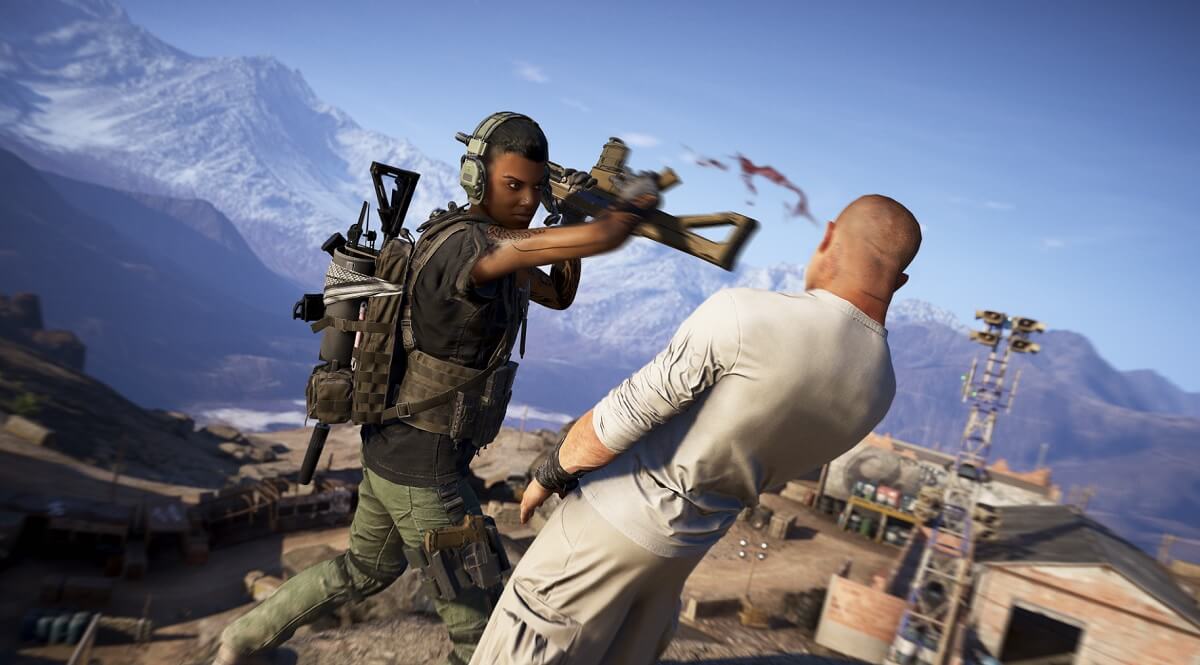
Above: Ghost Recon Wildlands has drop-in, drop-out co-op play.
Abboud: There are two elements to that question. The big thing we tried to do is create something that isn’t player-centric, but that has its own life and its own agenda. You might have noticed that the guards can go to sleep because we have a day-night cycle. From that point of view, the way we make it intelligent is by giving the A.I. its own agenda.
When it comes to combat specifically, yes, depending on the level of difficulty you choose, you’ll change as far as how much damage you can take, but the A.I. will also be more or less acute, because the stronger you are in a game like this the more or less aggressively you can play. The way we approached it in development — the good thing is, we were able to progress step by step. If we had been working on this game with no experience of previous Ghost Recon games, it would have been hell. But we have lots of experience, and we were able to move that into the new playground.
For instance, you can look at how we approached the synchronized shot, which was in Future Soldier. We had lots of experience setting up synch shots in close environments there. When we worked on the A.I. for our open world here, we had the basics down, because we’d already worked for a couple of years on how to organize the A.I. so they shoot when you want them to shoot and deal with what’s going on in the world around them. It was a lot more work to do that in this big open world, but it was a natural evolution of what we’d done in the past.
GB: It’s always hard to make very single aspect of an open world believable. Do you think that’s something that we’ll still be working on years from now?
Abboud: It’s a race and we’re part of it. We took some time to do research about Bolivia, studying things like how the local people dressed, the music they listened to, that kind of thing. It’s a part of trying to be as realistic and authentic as possible. But on the other hand, this is still a game. There’s a limit to how much realism you want in a game like this, because it some point it runs up against making the gameplay fun. If we made everything perfectly realistic it would be boring.
Just look at something like the day-night cycle. That maybe seems like a simple system, but we spent a long time over years of development working on that and changing it a lot. We’re still tweaking it. If you wanted to infiltrate a camp in the dark and you had to wait six hours in front of your computer for the sun to go down, you wouldn’t be very happy. But if we make the cycle too fast, you’d notice a break in the realism. If the sun is constantly moving, that’s pretty weird. We need to find a balance between not too fast, for the sake of realism, and not too slow, to keep the game fun.

Above: Your missions take you into underground compounds in Ghost Recon Wildlands.
If you look at how the game industry has evolved, we’re getting close to a moment where the question is no longer, “How do we make it realistic?” We can make something very realistic if we want to. The question is, “How do we make sure people have fun?” It’s very important to keep all the elements of our game working together — the military aspect, the open world, and the co-op play. Separating out any of that would have led to a very different game. With everything we build, we want to make sure those three elements are present and working together.
Because of the four-player co-op, we have the possibility that the characters were all split up. Years ago, if you wanted to make a game where the players could take off for opposite corners of the map, that wouldn’t be possible. You couldn’t stream the different parts of the level at the same time. You’d have no way to make sure the logic of the world stayed the same when they were together. Because of the technology we have now we’re able to do this. But then that changes the way we look at the size of the world.
When we were building our prototypes and making new iterations, pretty quickly we realized that we needed to have something big enough so that the freedom of splitting up was worth having. When we’re balancing the challenge of different combat situations, we need to make sure that there aren’t so many things interacting with you that you couldn’t use stealth effectively. It’s always a balance, pursuing authenticity and realism. At the end of the day we’re making games that we want to have fun with.
GB: I noticed that the helicopters fly a little more like the real thing. It’s not as much like driving a car as in other games. It seems like you chose to make flight more challenging.
Abboud: The helicopters are a very important element, both for the theme of playing as elite soldiers and for aspects of gameplay. We were talking about how to make sure travel doesn’t get too boring. Helicopters are a lot faster than the other tools you have for traveling, so we needed to make sure they still presented the right level of challenge. That’s why we built them that way. We made a lot of decisions as far as how we wanted it to feel so it made sense in terms of gameplay.

Above: You can ride in lots of vehicles in Ghost Recon Wildlands.
GB: You have to train a little bit more to fly it skillfully.
Abboud: Exactly. We expect people to spend a lot of hours inside this game, so there’s going to be a learning curve. What’s important is that you can still have fun early on in that curve. One of the great things about this game is that failure can still be fun. Let’s say you’re playing with three other people who you don’t know and who have different approaches. You can have fun succeeding with a perfect plan, but it can also be a lot of fun falling into unexpected situations.
That’s an important part of everything we build. We need to make sure that the time you invest in it is fun initially, when you’re learning the game, and also later on, when you’ve mastered more of it. And it can’t just be about increasing difficulty. You need to be able to find new things. Because of the quantity of stuff, the quantity of systems in this game, we’re still sometimes learning new things ourselves. We tweak one little thing in the A.I. and suddenly you can use it in some new way. We spend a lot of time just looking at the game, how it behaves, and trying to understand it.
A few years ago, when we were thinking about a mission, we might decide to put a particular vehicle in a particular place so you could start the mission, find that vehicle, drive from point A to point B, and end up right where you needed to be to succeed in the mission. Now that we have this fully open structure, though, you can take the vehicle you picked up in mission 27 and use it in mission 45. Because of the number of possibilities in the order of the missions, we can’t build this game thinking that a certain element will be absolutely necessary for a certain mission. We’re forced to see how all these different things can interact, as opposed to thinking about a mission as something scripted and linear. Very early on we said we didn’t want anything scripted in the game, and right now we’ve delivered on that. It’s just about the systems interacting together.
VentureBeat's mission is to be a digital town square for technical decision-makers to gain knowledge about transformative enterprise technology and transact. Learn More
